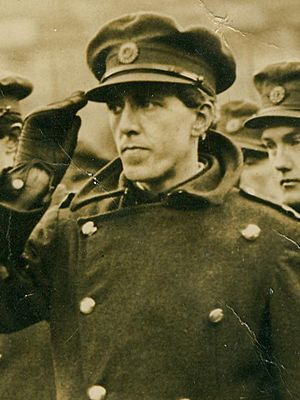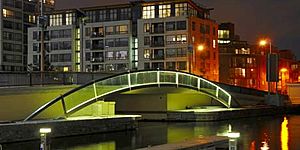Seán Mac Mahon facts for kids
Seán Mac Mahon (born John Michael McMahon, 15 September 1893 – 26 March 1955) was an Irish nationalist. He is best known for fighting in the 1916 Easter Rising. He later played an important role in the Irish Army.
Contents
Seán Mac Mahon's Early Life
Seán Mac Mahon was born John Michael McMahon in Dublin on 15 September 1893. His parents were Edward and Mary McMahon. Edward later worked as a maltster, which is someone who prepares malt for brewing.
Seán was the oldest of seven children. He had four brothers named Pat, Ned, Tom, and Joe. His two sisters were Annie and Kathleen.
After finishing school in 1907, just after his 14th birthday, Seán started working at the Dublin Post Office. He left there in 1909 when he turned 16. He then began working in an office, possibly for Plunkett Bros. Maltsters, where his father was a foreman.
Joining the Irish Volunteers
In 1913, Seán Mac Mahon joined the Irish Volunteers. This was a group of Irish nationalists who wanted Ireland to be independent from British rule. He became a member of "B" Company, 3rd Battalion, in Dublin.
By 1914, he was promoted to 1st Lieutenant. The next year, in 1915, he became a Captain. It is believed he was also an active member of the IRB, a secret society working for Irish independence.
Seán Mac Mahon in the Easter Rising
During Easter Week 1916, Seán Mac Mahon fought as a Captain. He was part of "B" Company, 3rd Battalion, under the command of Éamon de Valera. Their main location was Boland's Mills in Dublin.
Taking Control of Westland Row Station
Captain Mac Mahon's main job was to take control of Westland Row Railway Station. He and his men blocked off the station and cut telephone wires. They also took over signal boxes. Their goal was to stop British soldiers from using the railway. This would force any British reinforcements to march into Dublin.
Mac Mahon's men also sabotaged part of the railway line. They then dug in about 300 yards from the station. The railway was very important for De Valera's command area. Its defense was given to Mac Mahon and another officer, Joseph O'Connor, because they were considered "two of his best."
First Fight and Helping a Wounded Man
On the Monday of the Rising, Mac Mahon and seven of his men faced British soldiers near Bath Avenue. They fought them off and killed a sergeant major. The Volunteers used stone archways near the railway for cover. They shot at British soldiers on nearby streets and even at Beggars Bush Barracks.
One brave moment happened when one of Mac Mahon's men was badly wounded. Captain Mac Mahon himself, while still in his uniform and under fire, took the injured man to St Vincent's Hospital. This showed his dedication to his men.
Saving St. Andrew's Church
Towards the end of the fighting, De Valera, who was very tired, ordered the burning of Westland Row station. However, Captain Mac Mahon convinced him not to do it. Mac Mahon argued that burning the station would also likely burn St. Andrew's Church next door. This story is still told by the Mac Mahon family.
Capture and Imprisonment
After the Easter Rising ended, Seán Mac Mahon was captured. In May 1916, he was sent to prison. He was held first in Wakefield, then at Frongoch in Wales, and finally at Wormwood Scrubs prison.
While at Frongoch, he was involved in setting up a General Council of officers. He was also part of a group of prisoners who were court-martialled after an incident in the camp. He was sentenced to 28 days of hard labor but served 6 days in the camp.
He was released on Christmas Eve 1916, as part of a general release of prisoners.
After Release and Political Work
After his release, Seán Mac Mahon returned to Dublin. He worked as a clerk for Nationality, a newspaper owned by Arthur Griffith. Griffith was a very important leader in the Irish independence movement. Mac Mahon also rejoined the Volunteers and became Vice Commandant of the 3rd Battalion.
The South Longford Election
In 1917, Griffith sent Seán Mac Mahon and Joseph Curran to Longford. Their job was to help get Joseph McGuinness elected for Sinn Féin in a special election. McGuinness was in prison at the time. The election slogan was "Put him in to get him out!" Michael Collins also worked on this campaign. Sinn Féin won the election by a small number of votes.
During this time, the Volunteers became very active in South Longford. They helped organize voters, protected polling stations, and escorted ballot boxes.
New Leadership and Marriage
In October 1917, Éamon de Valera was elected President of Sinn Féin and later President of the Irish Volunteers. A new headquarters staff was created for the Volunteers. Seán Mac Mahon was part of a group of important members who met to choose a Chief of Staff. Richard Mulcahy was chosen for this role.
In 1919, Seán Mac Mahon became the Quartermaster General (Q.M.G.) of the Irish Republican Army (IRA). This meant he was in charge of supplies and equipment for the army.
Marriage and Family
On 27 November 1919, Seán Mac Mahon married Lucinda Fitzgerald. They were married in the Church of Saint Andrew in Westland Row, the same church he had helped save during the Easter Rising. His brother-in-law was Theobald Wolfe Tone FitzGerald, who painted the Irish Republic Flag that flew over the GPO in 1916.
Q Company and Meetings
Seán Mac Mahon helped organize the famous Q Company, which was based at Dublin Docks. This unit was formed in March 1921 and was responsible for getting supplies. He also organized Volunteers at railway stations across Ireland.
Many important meetings took place at Whelan's Pub on Parnell Street. This pub was owned by James Kirwan, a member of the Dublin Brigade. Key leaders like Richard Mulcahy, Oscar Traynor, and Mick Collins often met there. Collins even hid money in the pub to buy weapons. Plans for escapes from prisons like Kilmainham Gaol were also made there.
The 14 March 1921 Incident
On 14 March 1921, six IRA Volunteers were hanged in Dublin. This led to a general strike in the city. That evening, Seán Mac Mahon was at a meeting at the IRA headquarters at 144 Pearse Street. His brother-in-law, Leo Fitzgerald, was helping to protect the meeting.
British soldiers, called Auxiliaries, approached the building. A short but intense gunfight broke out. Seven people were killed or badly wounded, including Leo Fitzgerald, who died instantly.
Treaty and Civil War
The Anglo-Irish Treaty was signed on 6 December 1921. This led to the creation of the Irish Free State. Seán Mac Mahon continued as Quartermaster General when the new Irish Army was formed in February 1922.
When Michael Collins was killed in August 1922, Seán Mac Mahon was one of the people who carried his coffin.
In September 1922, Seán Mac Mahon became the Chief of the General Staff, the highest military position. He was not well-known to the public or even to the British at Dublin Castle. The army needed to become more professional and organized after the Civil War.
Supplying Arms to Northern Ireland
During this time, there was still violence against Catholics in Northern Ireland. The Free State Army decided to secretly buy weapons to send to IRA units there. General Mac Mahon approved a deal to buy arms from a dealer in London. However, this deal went wrong, and the weapons were not delivered as planned.
Retirement and Death
Seán Mac Mahon retired from the army in January 1927 due to poor health. He was asked to go into politics but chose not to. The army provided him with a house, but he later bought his own home in Dundrum, Dublin. He lived there with his wife, Lucinda, and their three children: Terence, Kathleen, and Seán.
Seán Mac Mahon passed away on 26 March 1955. He was buried with his wife and two of his children in Deansgrange Cemetery. He received a full state funeral, which is a special ceremony for important national figures. A Celtic cross marks his grave.
Memorial Bridge
In 1966, a new bridge in Dublin was named the Seán Mac Mahon Bridge. It is located near Boland's Mill, where he fought during the Easter Rising. President Éamon de Valera unveiled the plaques for the bridge. Before the ceremony, members of the Dublin Brigade IRA marched to the bridge to honor him.
This bridge was rebuilt in 2008 and rededicated in his name on 30 May 2008.



